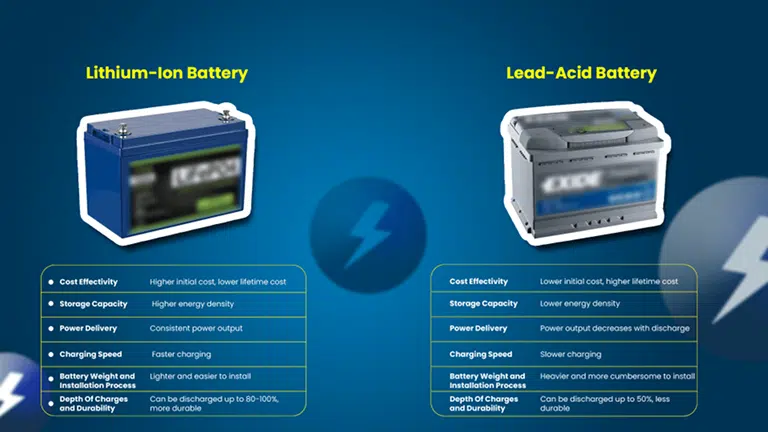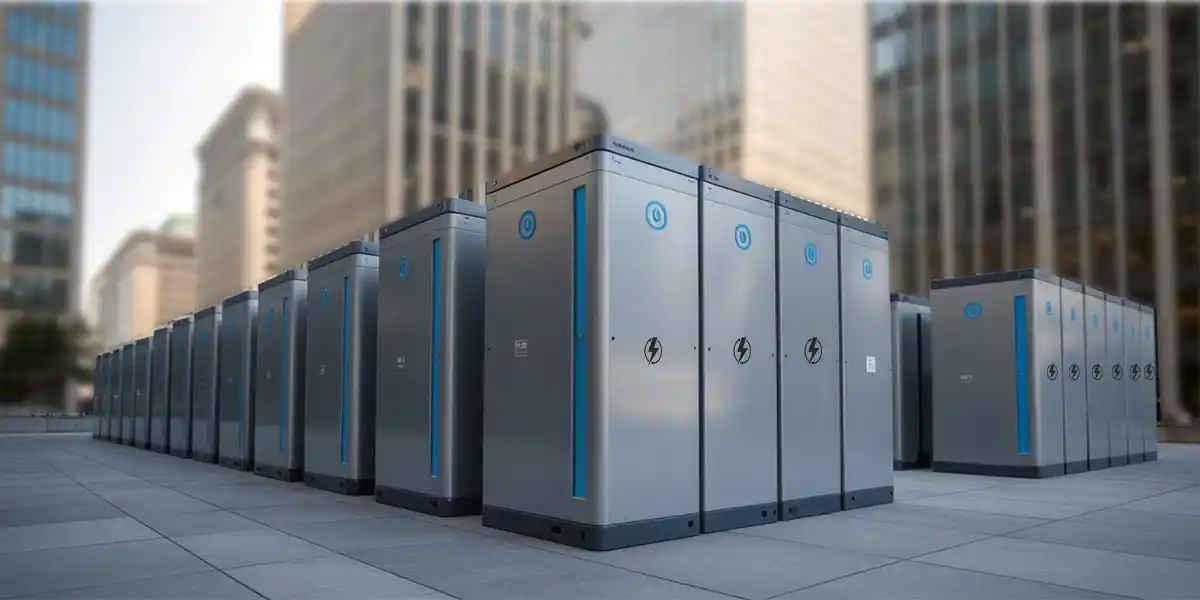- Updated On: July 29, 2024
Comparing Lithium-Ion vs Lead-Acid Batteries: Which One is the Best?
With the increasing demand for solar energy systems, the need for an efficient battery energy storage solution has become important for homeowners. Nowadays, lithium-ion and lead-acid batteries are commonly considered battery storage options in the market. The lead acid battery is popular due to its affordable price while lithium-ion batteries are known for their advanced technologies.
In this article, we will explore the difference between lead-acid and lithium-ion batteries by focusing on several aspects. This includes energy efficiency, cost, performance, longevity, and more. This comparison will help you make an informed decision for choosing the right battery storage for your home.

Lithium-Ion Batteries vs Lead Acid Battery – All You Need to Know
Both lithium ion and lead acid batteries have advantages and disadvantages. The lithium-ion batteries are rechargeable. It can be used in a variety of applications like electric vehicles and solar technology. Lead acid batteries are also rechargeable but are the oldest style. These batteries are cost-effective and can be used in automotive applications. Here, we will see what makes these two energy storage batteries different from each other. So, let us get into this without any delay:

Cost Effectivity
In terms of cost-effectivity, lead acid batteries outperform lithium-ion batteries. A lead-acid battery is affordable as compared to lithium-ion batteries. Moreover, these batteries also have lower upfront costs of around $100 to $200 per kWh. However, lithium-ion is expensive. The cost can also increase based on the installation and size. It can cost around $300 to $500. Conversely, the scalability and lifetime value balance the expensive cost of lithium-ion batteries.
Lithium-ion batteries are expensive. But they require fewer replacements and maintenance, which balances the cost.
Storage Capacity
Storage capacity measures how much energy the battery can store and discharge. This depends on the battery model and manufacturing. However, the lithium-ion battery has a higher energy density, which makes it better than lead-acid batteries. Discharging good energy density can power multiple appliances for prolonged periods.
Lithium-ion batteries have a strong storage capacity because of their higher energy density. It ranges from 150 to 200 Wh/kg. Moreover, its efficiency goes beyond 90%, which means you can use stored energy anytime. The cycle life of lithium-ion rechargeable batteries ranges from 500 to 1500 cycles. It leads to better capacity retention.
This also escalates the capacity used for each charge cycle. Because of compromised energy density ranging from 30 to 50 Wh/kg, it has lower storage capacity. They have a lower efficiency of about 80%, limiting usable capacity. The cycle life of lead-acid batteries is 200 to 400 cycles. This leads to lower capacity retention.
Regarding storage capacity, lithium-ion batteries are a better and reliable option.
Power Delivery
Throughout the discharge cycle, lithium-ion batteries’ power delivery remains constant. The stable voltage delivery makes them reliable rechargeable batteries. It helps to store energy generated by solar panels. Lithium-ion batteries can deliver higher discharge rates, which leads to unmatchable power delivery. It is very helpful for appliances requiring a quick burst of power. In addition, the internal resistance in these batteries is almost negligible. It results in less energy loss and better performance.
Lead-acid batteries, start with strong power delivery but get lower at the end. Moreover, it stores less energy per unit and has a lower discharge rate. Thus, they deliver power at a lower and unstable rate, which makes them unsuitable for big appliances needing high and consistent power. The higher internal resistance causes greater energy loss. This makes them less efficient and also impacts energy usage.
The power delivery of lithium-ion batteries is higher and consistent. So, lithium-ion batteries are a reliable option.
Charging Speed
Charging speed shows a lot about the functionality of the batteries. It’s approximately four times faster in lithium-ion batteries than in lead-acid batteries. In almost 30 minutes, it can charge up to 80%. Moreover, the lithium-ion battery can also accept high charging currents without any damage.
The lithium batteries are capable enough to handle up to 1C or higher charging rates. The constant current phase boosts the charging speed and increases battery life. Because of rapid charging, there are no degradation issues.
In lead-acid batteries, the charging speeds are extremely slow. This battery can take more than 8 to 16 hours to charge completely. Moreover, it has a lower charge current acceptance. The lead acid battery can only charge around 0.1C to 0.3C. So, it’s unsuitable if you need batteries that can charge swiftly.
One of the points to note is that this battery has three charging stages: bulk, absorption, and float. This compromises the battery’s lifespan and can result in issues like overcharging.
Lithium-ion batteries have better charging speeds. You don’t have to keep lithium batteries on float charge. This makes them best for both commercial and residential solar setups.
Battery Weight and Installation Process
The installation process plays an important role in the performance of a battery. Lithium-ion batteries are lightweight, making them easier to carry, transport, position, and install. The compact design allows you to install them in several orientations. The installation flexibility lets you use space efficiently.
Yet, you cannot install a lead-acid battery in an inverted position because it can cause venting issues. These batteries are heavier and consume more space. Moreover, you need to install them in a specific orientation. Lead-acid batteries also emit gasses during operation, which requires an expensive ventilation system.
Lithium-ion batteries are securely sealed, and have no installation restriction. This makes it a convenient battery. You can install it in any orientation without worrying about the venting issues.
Depth of Charges and Durability
This defines the percentage of the battery’s capacity that can be drained effectively without damaging the battery. In a single cycle, 85% or more of lithium-ion batteries are discharged. Moreover, lithium batteries require lower maintenance. However, the lead-acid battery does not go beyond 50%, which damages the battery and impacts its lifetime. Yet, lead-acid batteries require regular maintenance that affects their longevity.
Note: The lithium-ion batteries outpower the lead acid because of their higher depth of charge and sustainable durability.
Which one is the best?
Lithium-ion batteries are more reliable and efficient solar batteries than lead-acid batteries. This is because it has greater capacity, higher energy efficiency, and a reliable lifespan. Moreover, they are lighter in weight, and the installation process does not have complications.
In summary, lithium-ion batteries are the most reliable and effective in comparison to lead-acid batteries. It is helpful in providing optimal relief from power outages. Moreover, you can get electricity even after the sun is not shining.
A solar storage solution is a reliable choice to fulfill backup power needs without any hassle. This comparison also summarizes that using lithium-ion batteries is good because it has a prolonged time span and has the fastest charging speed.
Are you are looking for a suitable battery storage option for your home? Solar SME is here to help you out. Our energy consultants will guide you on the best battery storage option. Get a FREE Estimate with our smart solar calculator NOW!
Related Articles:
The demand for battery backup solutions is surging in the U.S. as people are now finding ways to reduce their reliance on grids.
Extreme weather and long power outages are becoming increasingly common in the United States. One storm can leave your home without power for several days.
Energy storage is a pivotal backup solution for smart companies to address energy crisis effectively. From reducing peak demand charges to integrating renewable energy sources, energy storage systems offer a multitude of benefits for businesses. Explore more!



